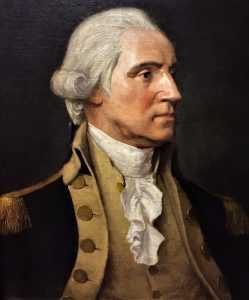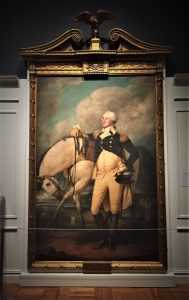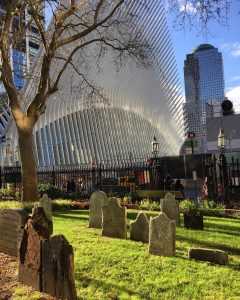WANDERLUST

George Washington was not really a New Yorker. He was born, raised and died in Virginia. He spent much of his public life, as both a president and a general, in his favorite city of Philadelphia. But New York? Not so much.
It’s hard to blame him. He fought six battles trying to defend New York, and lost them all, but one. When he finally retreated from New York, he wanted to burn the city to the ground, but Congress stopped him. Officially, at least. No one really knows who started the fire on Sept. 21, 1776, but George was not disappointed when hundreds of houses in New York did in fact go up in flames.
Despite all this, George Washington probably did have some very fond memories of the city. It was in New York that he was sworn in as president and spent 17 months, before the capital was moved to Philadelphia. And it was here that the Revolutionary War officially ended in 1783, with a triumphal march by the Continental army down Broadway, stopping from tavern to tavern to drink 13 toasts at each one in celebration of the new country.

Because New York was so small at the time of the Revolution, most of the sites associated with George Washington are within a short walk of each other. You can have a drink and a meal at his favorite tavern, see the pew he sat in at his church, view the gravesite of his trusted chief of staff (and current pop star) Alexander Hamilton, stand on the spot where he was sworn in as president and walk across the Brooklyn Bridge, passing almost directly over the spot where he retreated after the Battle of Brooklyn, saving the army in what has been called the most magnificent military retreat in history.
As George might have done himself, it’s best to begin the tour with a drink.

Fraunces Tavern
When Samuel Fraunces opened his tavern here in 1762, there were already 217 taverns in New York to serve just 13,000 people. Today, it is the only colonial tavern to survive and the oldest establishment serving food and drinks in New York.
Taverns at the time were a combination of an inn where you could stay and a public house where you could get a drink and meal. Both offerings were pretty dreadful. People shared beds and sat at simple communal tables, often arranged around a fireplace, with a mishmash of different flatware and glasses. Taverns were expensive because patrons had to pay not only for food and drink, but also for the candles used.

The average colonial of the day drank a staggering four gallons of hard liquor and 14 gallons of beer or cider a year, and since pipe smoking was common, the room would be filled with smoke, gambling, gossip and politics. Taverns were hotbeds of radical ideas, and because Samuel Fraunces (or Black Sam, as he was called by friends) was a revolutionary, his tavern was home to the Sons of Liberty and other rebels.
When the British captured New York in 1776 and occupied it for seven years, they forced Samuel to seek safer ground and his son-in-law, a Tory, took over the tavern. But on Nov. 25, 1783, the day the war officially ended, the British departed, General Washington marched in and he and 185 friends gathered at Fraunces Tavern for a celebration dinner. In New York, Nov. 25 was known as “Evacuation Day,” and was an official holiday for more than 100 years.
George had promised his wife Martha he would be home in Mount Vernon for Christmas, so after eight days of celebration in New York, it was time for one last farewell luncheon party — the last time, as far as any of them knew, that Washington and his army officers would ever see each other. Washington fully intended to retire to his home and become a farmer, far from public life.
For the last meal, the tavern laid out an impressive spread of cold meats, but the atmosphere was so sad, no one touched their food. The best known account, written by Colonel Benjamin Tallmadge, and now on display in the restaurant’s museum, described the scene as General Washington entered the room:

“His emotions were too strong to be concealed which seemed to be reciprocated by every officer present. After partaking of a slight refreshment in almost breathless silence, the general filled his glass with wine and turning to the officers said, ‘With a heart full of love and gratitude I now take leave of you … I cannot come to each of you, but shall feel obliged if each of you will come and take me by the hand.’”
“General Knox being nearest to him, turned to the commander-in-chief who, suffused in tears, was incapable of utterance, but grasped his hand when they embraced each other in silence. In the same affectionate manner, every officer in the room marched up and parted with his general in chief. Such a scene of sorrow and weeping I had never before witnessed and fondly hope I may never be called to witness again.”
Good thing he wasn’t at any Hillary parties the night of the election.
You can see the actual room where this emotional farewell took place upstairs in the Fraunces Tavern Museum. This is a gem of a museum. In Boston or Philadelphia it would be a huge attraction, but somehow in the overwhelming opportunities of New York, it gets lost. You might find, as I did on a recent Friday afternoon in December, that you have all two floors of it to yourself.

The Long Room, where the dinner took place, has been reconstructed as it might have looked on that afternoon. It is a typical colonial dining room, with wood table and chairs, candles and framed prints, and actually not that different from the one you can dine in downstairs. But the rest of the museum is a kick. There’s one of Martha’s silk shoes, the last letter from spy Nathan Hale (who was hung in 1776 and has a statue nearby at City Hall), and a wild assortment of trinkets and mementos from the Revolution and those who have preserved its history. Currently, for the first time, there are 47 paintings of the Revolution by master illustrator John Ward Dunsmore. This is the only time the paintings have all been together and they chronicle the entire war. He worked for a calendar company, and these paintings will be familiar to anyone who has ever had any interest in the colonial period.

George was no stranger to taverns or liquor. He liked wine, beer and cider and was at one point the largest manufacturer of whiskey in the nation. Three of his dogs were called Tipsy, Tippler and Drunkard.
After the museum, the restaurant is a bit eclectic, with offerings from jambalaya to lobster tortellini, but for those desiring authentic, there are beef and chicken pot pies, Scotch eggs and something called George Washington’s Horseback (bacon, dates and almonds).
The atmosphere? It could not be better. The main dining area (the Tallmadge Room, named after the colonel) has a gorgeous room of wood tables lit by candles. There is a maze of corridors that lead to private dining areas and a bar with stuffed chairs, a roaring fireplace and enough wood and prints to make George feel at home.
The biggest surprise, is the Porterhouse Brewing Company, which has taken over half the main floor and has 140 craft beers to try, including a range of craft beers all brewed in Ireland. It’s all wood, mirrors and brass with brightly lit bottles and little nooks carved out for private gatherings around communal tables. Other than the no smoking laws, it’s pretty certain that the Sons of Liberty could still gather here and talk about The Donald pretty much in the same way they once did about George III.

Neighborhood Walks with George in Lower Manhattan
The great thing about Fraunces Tavern is that it is in the heart of Lower Manhattan. Just a short musket shot away is Stone Street, the first paved street in New York. Now closed to traffic as a historic district, the petty cobblestone way is lined with taverns and restaurants and evokes a feel for, if not colonial New York, at least the old New York of The Godfather Part II. In summer, the two-block area is filled with outdoor umbrellas and is one of nicest places to dine in the city.
A block in the other direction takes you to Battery Park, which in George’s time was an island and fortress with 100 cannons. Today it’s been connected to the mainland and has one of New York’s oldest standing forts (Castle Clinton from the War of 1812) and two emotional memorials. The Sphere designed by Fritz Koenig was a monument to world peace that stood in the plaza in front of the original World Trade Center. In the 9/11 attacks, it was buried under tons of rubble, torn apart, bent and scraped, but it was dug up, reassembled and now sits in Battery Park as a testament to New York’s resiliency.

Nearby, the Merchant Marine Memorial is truly eerie. Commemorating the 7,000 merchant marines who died in World War II, it depicts a sinking ship and drowning sailor with his arms stretched out of the sea. Depending on the tide, you see half of his body or just his arm and neck reaching out for help.
New York’s famous Broadway starts at the intersection of Battery Park and Bowling Green (a small green triangle where George could have enjoyed the passion of the day: outdoor lawn bowling). Here you’ll find the 7,000-pound bronze Charging Bull sculpture by Arturo Di Modica that has become the symbol of a bull market on Wall Street. Rub its nose for luck, and continue up Broadway to the beautiful Trinity Church, where Alexander Hamilton is buried.

The first Trinity Church was destroyed in the fire that George didn’t set in 1776; the current church dates to 1846. At first Hamilton was not allowed to be buried in the quiet churchyard, where gravestones date back to 1680. The church strongly disapproved of dueling and did not want to be seen as sanctioning it. Ironically, Hamilton’s son was killed in a duel three years before, and is thought to be buried in the same graveyard, but because of the stain of dueling, his grave was unmarked. Hamilton lingered for several days after his famous duel with Vice President Arron Burr and was able to plead in person from his deathbed with Reverend Benjamin Moore, rector of Trinity, and finally was allowed to be buried at the church. Today, thanks to the hit musical, his grave is a popular site for selfies.
From the church, cross Broadway and head down Wall Street and you’ll soon see George Washington’s statue on the steps of the Federal Hall National Monument. The statue is approximately where George was inaugurated as president (although at the time, he was inside another building that stood here. The statue is the same height and street location as where he stood).
Anywhere else in the nation — or the world — Federal Hall would be famous. In New York, the 1842 modified version of the Parthenon is overshadowed by, well, everything else. But climb the steps and go in — the rotunda is amazing, it’s free, there’s a lot of history and (always important in New York) there are clean, free public restrooms. There are exhibits on the inauguration and the Revolution in New York, and a there’s a fascinating “All George” gift shop offering everything from Christmas ornaments to bookmarks featuring his familiar face.

One of the most iconic images in New York is to frame the statue of George at Federal Hall with the famous gigantic flag that hangs on the New York Stock Exchange across the street. If you look closely, you’ll see that the stock exchange is on Broad Street, not Wall Street. Less well known is that yet another of New York’s terrorist attacks took place here in 1920 when 31 people were killed by a bomb placed in a horse and carriage. The building across the street from Federal Hall still has pot marks from the explosion.
Back on Broadway, it’s three blocks to St. Paul’s Chapel, known as “the little chapel that stood.” Built in 1766, the chapel survived not only the great fire of 1776, but also the attack on Sept. 11, that brought down the two twin towers of the World Trade Center, located directly across the street. St. Paul’s was not damaged and became a place of refuge for the firefighters, police officers and other first responders working through the devastation.

St. Paul’s was George Washington’s church in New York. You can see a replica of George’s modest pew box, where he prayed after the inauguration. The churchyard is particularly moving. George certainly walked through the gravestones here, because this was the main entrance to the church in his day. It is a truly a spectacular sight to see gravestones from the 1700s with Santiago Calatrava’s new World Trade Center Oculus Pavilion directly across the street.
Finally, from the front of the church on Broadway, head to the ramp that is the pedestrian walkway over the Brooklyn Bridge crossing the East River. George had entered New York in the spring of 1776 as the hero who had driven the British out of Boston. But then the Empire struck back, sending the largest armada of ships and men the world had ever seen at that point.

Washington tried to defend all the potential landing points, but the British outmaneuvered him and put 30,000 redcoats on Long Island. Then they conducted a secret night march around Washington’s flank, and in what became the Battle of Brooklyn, the largest battle of the Revolution, they badly beat him and almost destroyed the U.S. army. Only a valiant last stand by Maryland troops at the Old Stone House saved the day.
Near the Park Slope neighborhood in Brooklyn, in Washington Park, the Old Stone House Building is now a museum. It is a reconstruction of the 1699 Vechte-Cortelyou House in the exact location where the battle took place. The museum has models and exhibits of the battle, but it takes a lot of imagination to picture this place in 1776.
Easier is to look down at the East River from the Bridge. With the victorious British to his front, and the river to his rear, Washington had only one option: somehow he had to retreat and ferry his men across the East River without the British knowing it. The embarkation point was the little shore-side park, Fulton Ferry Landing, just to the north of the Bridge on the Brooklyn side. Keeping fires on the front line burning as a disguise, and in a providentially thick fog, Washington managed to extract his entire army of 9,000 men back to Manhattan to give them a chance to fight another day.
A retreat may not be the most glorious of military maneuvers, but if George Washington had not managed to retreat from New York, there almost certainly would be no United States of America. And for that, New Yorkers … and George Washington … were always grateful.
This is an interesting site that lets you walk all the important spots of the Battle of Brooklyn.










